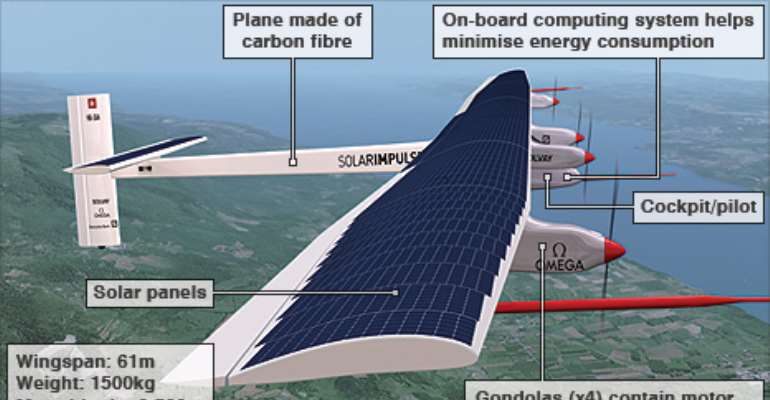SOLAR IMPULSE PLANE STARTS 24-HOUR TEST FLIGHT

An experimental aircraft that draws its power from the sun is making a round-the-clock test flight.
The aim is to assess whether the plane can fly in darkness, using solar cells on its wings to generate enough power to stay in the air for 24 hours.
The HB-SIA plane, which took off from Switzerland, has the weight of a family car but the wingspan of a big airliner.
The test flight was initially due to take place last week but was postponed because of a technical problem.
“For seven years now, the whole team has been passionately working to achieve this first decisive step of the project,” said pilot Andre Borschberg as he entered the cockpit at an airfield in Payerne, in the west of Switzerland.
He is to take the aircraft to an altitude of 27,900ft (8,500m) by late Wednesday, when the sun's rays stop being strong enough to supply the solar cells with energy.
The prototype will then start a slow descent using energy stored in its batteries until sunrise.
“The big question is whether the pilot can make efficient use of the battery energy to fly throughout the night,” the team said in a statement.
“If this mission is successful, it will be the longest and highest flight ever made by a solar plane.”
'Solar future'
The plane, which has 12,000 solar cells, is the latest step in the Solar Impulse project, which Mr Borschberg leads with his business partner and fellow adventurer, Bertrand Piccard.
Mr Borschberg (L) and Mr Piccard have worked on the project for seven years
Mr Piccard made the first non-stop circumnavigation of the globe in a balloon in 1999.
The pair want to prove that solar power has a practical future in aviation and, more generally, in powering society at large.
The plane incorporates composite materials to keep it extremely light, and uses super-efficient solar cells, batteries, motors and propellers to keep itself in the sky.
The vehicle was unveiled last year and has since been undergoing daylight trials. The first full-day flight was completed on 7 April.
The HB-SIA will be succeeded by HB-SIB. It is likely to be bigger, and will incorporate a pressurised capsule and better avionics.
The group plans to use this vehicle in two years' time to make the first manned transatlantic solar flight, followed in 2013 by an even more daring circumnavigation of the Earth.
